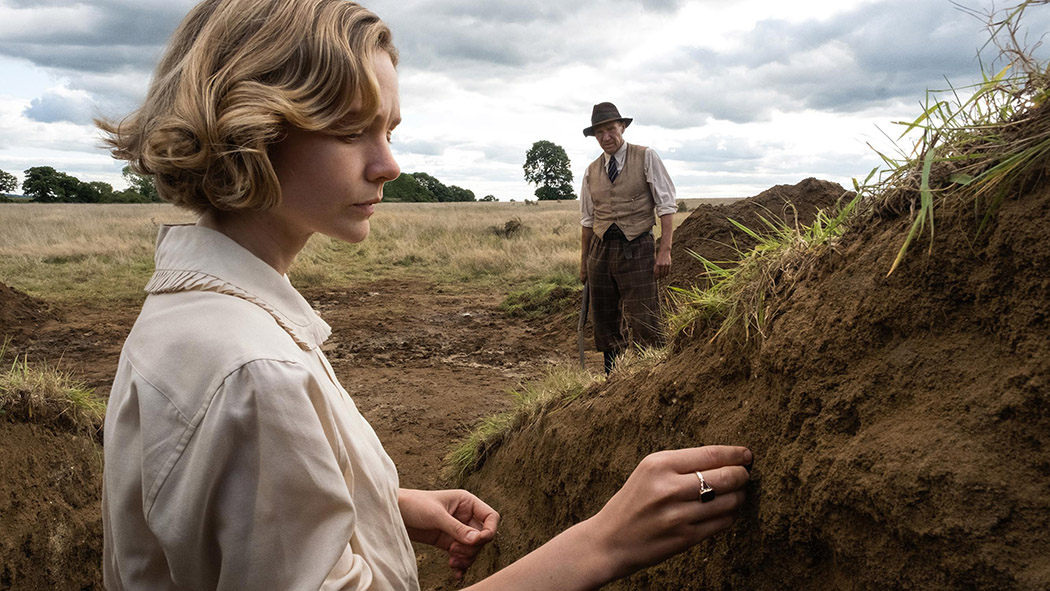By Deirdre Crimmins
There is a nugget of wisdom within the silly 1996 Michael Keaton film Duplicity. When explaining why one Keaton clone is not as smart as the others, he quips, “You know how when you make a copy of a copy, it’s not as sharp as…well…the original.” Given that The Dig is an adaptation of a fictionalized novel of a true archaeological dig, the film turns out to be not quite as sharp as it could have been.
Focusing on the events and people surrounding the Sutton Hoo dig in Suffolk, England, in 1938, The Dig is not afraid of getting dirty, literally. Edith Pretty (Carey Mulligan) lives on a large, English estate that she and her late husband suspect has treasure buried below it. Not under the mansion itself, but in the adjacent land, underneath whale-sized mounds of soil that look like strange geological features. These humps of land stand out in the field, and Edith is fairly certain they contain secrets. She hires excavator Basil Brown (Ralph Fiennes), finds him some strong helpers, and tells him to get digging.
In actual history, these mounds contained some of the richest treasures of the Anglo-Saxon period. It is hard to overstate the importance of this discovery, and the film is quite successful in showing us the weight of this find. As more diggers, with escalating degrees of educational pedigrees and importance at the British Museum, come to the site to work with Basil, their excitement is contagious. Director Simon Stone takes his time to convey, visually and musically, the uniqueness of such a find. Not only is this a moment for these dedicated historians personally, it is a moment of significance for the profession. The music soars as the cameras zoom in on each artifact as it is unearthed.
Where The Dig stumbles is in its attempt to include far too many subplots. When the film starts, it is a battle of wills between Edith and Basil. They both have a vested interest in history and exploration of the soil near her home. Mulligan and Fiennes have strained chemistry, but manage to show their characters’ dedication to the project and mutual affection for its completion. But The Dig never lets us get too close to their relationship before it turns to the politics of the British Museum and the National Trust taking over the project.
Then there’s the pesky subplot about Edith’s failing health, and her son’s hesitance to visit his father’s grave, not to mention the complicated marriage between two of the diggers, and the romantic drama that ensues with them. Nearly halfway through the film, we lose track of Edith and Basil and are suddenly presented two brand new characters with little to no backstory. And we have yet to discuss the sweet but barely addressed friendship between Edith and the only female excavator Peggy (Lily James). Oh, and then World War II starts.
This disorganization of attention and emotion within the film is a common issue with adaptations of sprawling literature. It’s a struggle to decide which elements to include and which to strategically ignore in any film with a reasonable running time. Here, the rush to include all of the characters left their individual depth and complications behind, and the scraps are not nearly as rich as they could be.
This is a pity because The Dig has plenty of elements in its favor. The score and rich cinematography handle a lot of the romanticism of the findings. There is no doubt that this dig will be one of the most important moments of the characters’ lives, and we feel it along with them.
As the excavators get deeper in the Earth, there’s mention of a tomb of sorts, and they are wary about glee over digging up the dead. Add to that Edith’s deceased husband and the infancy of a new global war, and suddenly the reverberations of tinkering with someone’s final resting place carry more gravity. But this fascinating ponderance is never a major focus in The Dig. It is teased enough to show the kernel of a thought, but just like the characters, it is never fully developed.
